Trees Birds Mammals Fish Amphibians Reptiles
Wild Algarve
Bookshop
Mycena epipterygia (Scop.) Gray - Yellowleg Bonnet
Phylum: Basidiomycota - Class: Agaricomycetes - Order: Agaricales - Family: Mycenaceae
Distribution - Taxonomic History - Etymology - Identification - Culinary Notes - Reference Sources
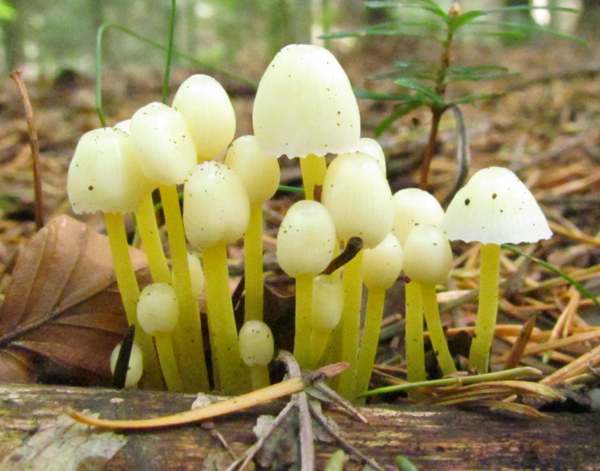
Many of the bonnet fungi are difficult to identify with
confidence, but the greenish-yellow stems of Mycena epipterygia are a
distinguishing feature of this delicate little autumn fungus, which seems to be equally at home in woodlands or in grassland.
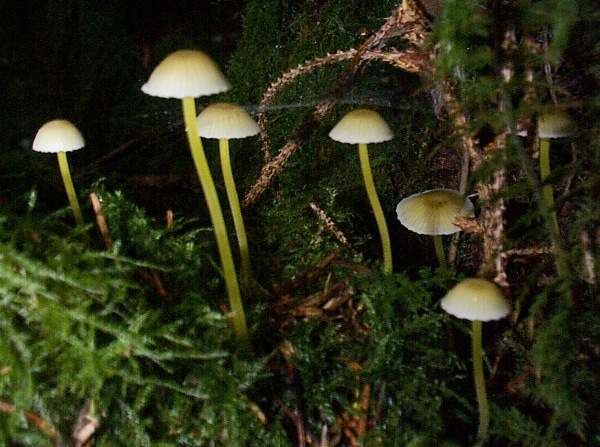
Distribution
This tiny gregarious bonnet fungus is common and widespread in Britain and Ireland as well as in most of mainland Europe. This species is also recorded in parts of North America.
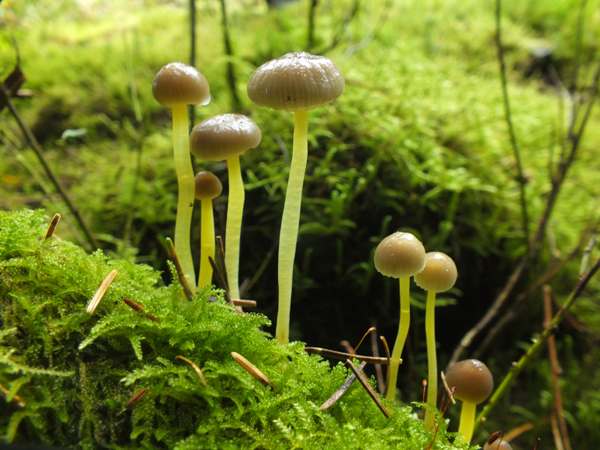
Taxonomic history
When in 1772 Italian mycologist Giovanni Antonio Scopoli described this little bonnet mushroom he gave it the name Agaricus epipterygius. (In the early years of fungal taxonomy most of the gilled mushrooms were included initially in the genus Agaricus, the contents of which has since largely been redistributed across several newer genera.) The currently accepted scientific name Mycena epipterygia dates from 1821, when the British mycologist Samuel Frederick Gray (1766 - 1828) transferred this species to the genus Mycena.
The Yellowleg Bonnet has accumulated quite an array of synonyms including Agaricus epipterygius Scop., Agaricus flavipes Sibth., Agaricus nutans Sowerby, Agaricus citrinellus Pers., Mycena epipterygia var. epipterygia (Scop.) Gray, Mycena flavipes (Sibth.) Gray, Agaricus plicatocrenatus Fr., Mycena citrinella (Pers.) P. Kumm., Mycena plicatocrenata (Fr.) Gillet, and Mycena splendidipes Peck.
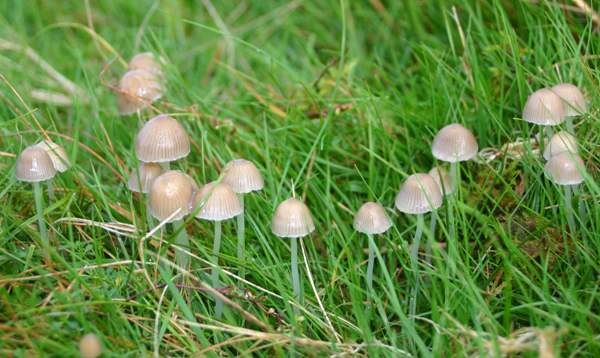
Etymology
The specific epithet epipterygia comes from the prefix epi- meaning upon and pterugion meaning 'resembling a (small) wing'. Something of a flight of fancy, perhaps? It is reported to mean 'on ferns', and these bonnet mushrooms do indeed grow sometimes on the rotting remains of ferns.
The common name Yellowleg Bonnet is self explanatory... until you come across a group of these mushrooms where, like those shown above, the dominant colour of the stems is green!
Although Mycena epipterygia is most often seen on woodland floors and (as shown above) less frequently in grassland, particularly beside hedgerows and woods, I have also seen a group of these pretty little bonnet mushrooms growing from a twig on a standing dead pollard (probably Hazel) at head height in damp mixed woodland. It's certainly worth looking up as well as down when in search of Mycena species!
Identification guide
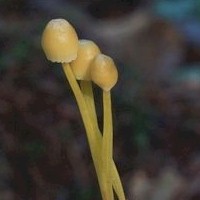 |
The translucent nature of these tiny bell cap fungi
together with their long, lemon-yellow to greenish stems make them relatively easy to
find despite their small size. |
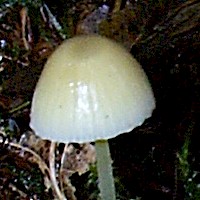 |
Cap
1 to 3cm in diameter when fully mature, the
fragile caps are mid- to dark olive-brown with a paler edge.
Initially bell-shaped, the striate caps expand to become convex. In
some instances the cap flattens and the margin turns upwards slightly, revealing the gills.
The cap flesh is white and thin above a translucent flexible pellicle (cap skin) which can easily be peeled off - a helpful identification feature. |
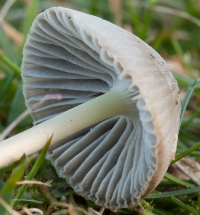 |
Gills
Adnate or slightly decurrent, the
gills are white or cream with a slight pink tinge when fully mature. |
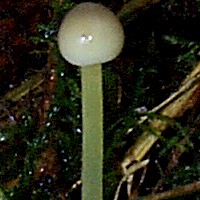 |
Stem
Relative to the cap size, these bonnet mushrooms have unusually long, fragile
stems. Just 1 to 3mm in diameter, the smooth, lemon-yellow viscid stems are
untapering and 3 to 7cm tall with no stem ring.
The stem flesh is almost white. |
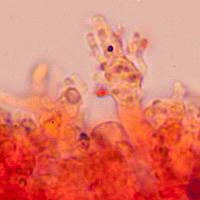 |
Cheilocystidia
Cheilosystidia (cystidia on gill edges) are up to 35µm long and extremely misshapen with irregular outgrowths. Pleurocystidia (cystidia on the gill faces) are absent.
|
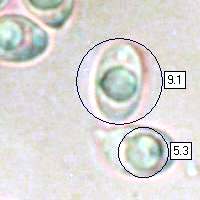 |
Spores
Broadly ellipsoidal to cylindrical, smooth, 8-11 x 4-6µm; amyloid.
Spore print
White or very pale buff. |
Odour/taste |
Faintly mealy odour; no distinctive taste. |
Habitat & Ecological role |
Saprobic, mostly in coniferous woodland but a variety
of this species is also found in damp grassland and moss. |
Season |
August to November in Britain and Ireland. |
Similar species |
There are many other small, bell-shaped fungi in the Mycena genus; however, the lemon stem of this striking species helps to distinguish it
from the other common species found in similar habitats. |
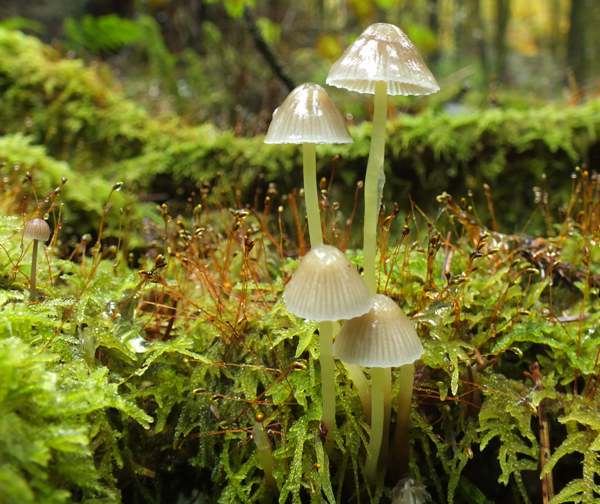
Culinary Notes
These little mushrooms are reported to be edible, but they are so insubstantial that they are definitely not worth collecting to eat.
Reference Sources
Fascinated by Fungi, 2nd Edition, Pat O'Reilly 2016, reprinted by Coch-y-bonddu Books in 2022.
Penny Cullington, (Oct. 2013). British Mycenas - Brief Descriptions.
Giovanni Robich, (2003). Mycena d'Europa; Associazione Micologica Bresadola ; Vicenza : Fondazione Centro Studi Micologici.
British Mycological Society. English Names for Fungi
Dictionary of the Fungi; Paul M. Kirk, Paul F. Cannon, David W. Minter and J. A. Stalpers; CABI, 2008
Taxonomic history and synonym information on these pages is drawn from many sources but in particular from the British Mycological Society's GB Checklist of Fungi.
Top of page...
Fascinated by Fungi. Back by popular demand, Pat O'Reilly's best-selling 450-page hardback book is available now. The latest second edition was republished with a sparkling new cover design in September 2022 by Coch-y-Bonddu Books. Full details and copies are available from the publisher's online bookshop...